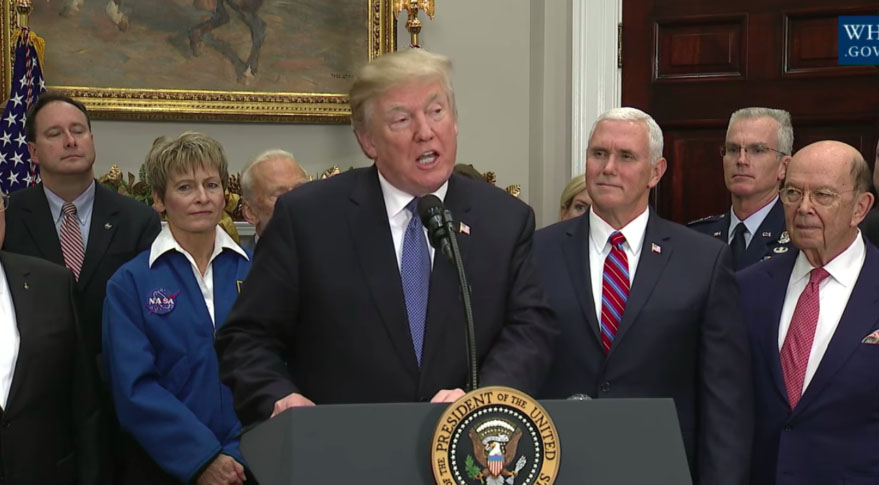Trump's National Security Strategy to Stress Technological Innovation

WASHINGTON — President Trump is unveiling a new national security strategy that focuses on ensuring U.S. economic prosperity, defending the homeland and posturing the nation to compete against rising technological powers. In the strategy, the administration coins the phrase “national security innovation base” to describe a key asset that the United States must protect.
The president will roll out the strategy Monday afternoon in a speech at the Ronald Reagan Building and International Trade Center here. According to a senior administration official, Trump is "excited" about the strategy because it "accurately reflects his priorities." [From Ike to Trump: Presidential Visions for Space Exploration]
There are four central themes in the strategy:
- Protecting the homeland. This includes securing borders, combating extremists and jihadists, and transnational criminal organizations.
- Promoting American prosperity. A broad theme is that economic security is essential to national security, thus the need to protect the "national security innovation base." This is term coined by the administration to capture the “broader ecosystem of activities that we need to make sure we protect so we can innovate," a senior administration official told reporters in a conference call. The strategy emphasizes “preserving our technological lead," the official said. "The national security innovation base needs to be protected."
- Preserving peace through strength. The readiness and modernization of the U.S. military are key priorities, in conventional war fighting but also in cyber, space, and nuclear forces. "We are looking at threats posed by competitors in those areas," the official said.
- Advancing American influence. The strategy calls for the United States to "find areas of cooperation with both allies and competitors," the official said. "'America first' does not mean America alone." The United States also will change how it promotes international development from a “grant-based mentality” to one that is driven by private-sector activity. Organizations like the United National and NATO are recognized in the strategy. "We believe in the importance of these institutions."
The "national security innovation" theme seeks to bring attention to the competitive pressures that threaten U.S. dominance in technology. "China is a competitor," the administration official said. "We take the view that we live in an ever-competitive world, and that the global balance of power has shifted in an unfavorable manner to American interests." The administration believes the nation needs to regain "strategic confidence to lead abroad."
The administration sees the U.S. innovation base coming under threat by "serious intellectual property theft" by China and other actors. "We need to protect our data, and ensure that CFIUS legislation is up to date," the official said, referring to the committee of government agencies that oversee foreign investments in U.S. companies.
Notably missing in the strategy is any mention of climate change as a security threat. The Pentagon for years has listed climate change as a national and global security challenge, but Trump chose to not include it in the strategy for the same reasons he withdrew the United States from the Paris climate accord. "It does not benefit American interests," the administration official said. "The president believes in America not having to apologize for its energy record."
The national security strategy, which presidents by law must produce and submit to Congress, will serve as the foundation for a series of documents that will shape the nation’s security agenda and military spending: The national defense strategy, the national counterterrorism strategy, the national biodefense strategy, the nuclear posture review and the ballistic missile defense review. All are expected to come put in 2018.
Breaking space news, the latest updates on rocket launches, skywatching events and more!
Defense Secretary Jim Mattis told reporters Friday that he was pleased with the White House coordination process in the preparation of the strategy. "We have worked very closely with Dr. Nadia Schadlow, who kind of had the lead for it, Ms. Dina Powell and others," Mattis said.
Schadlow is a deputy assistant to the president and the National Security Council staffer in charge of writing the strategy. Powell is the outgoing deputy national security adviser.
"We brought the military factors into it," said Mattis. "It was very collaborative. We had an open invitation to be there, and we took full advantage of it, giving our inputs. … Within a month we'll have our [national defense strategy] out, and it’ll show that we’re integrated and aligned with it."
This story was provided by SpaceNews, dedicated to covering all aspects of the space industry.

Sandra Erwin covers the military and national security beat as a Senior Staff Writer at SpaceNews. Sandra, based in Arlington, Virginia, specializes in Defense Department and Intelligence Community space programs, policy, budgets, technology and the industry that supports this sector. She joined SpaceNews in October 2017. Before coming to SpaceNews, Erwin covered the U.S. military, the Pentagon, Congress and the defense industry for over two decades as editor of the National Defense Industrial Association's National Defense Magazine and Pentagon correspondent for Real Clear Defense.

